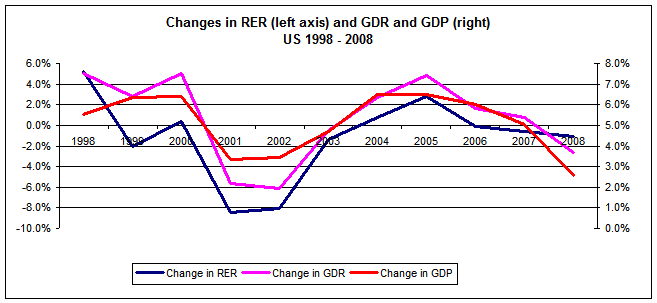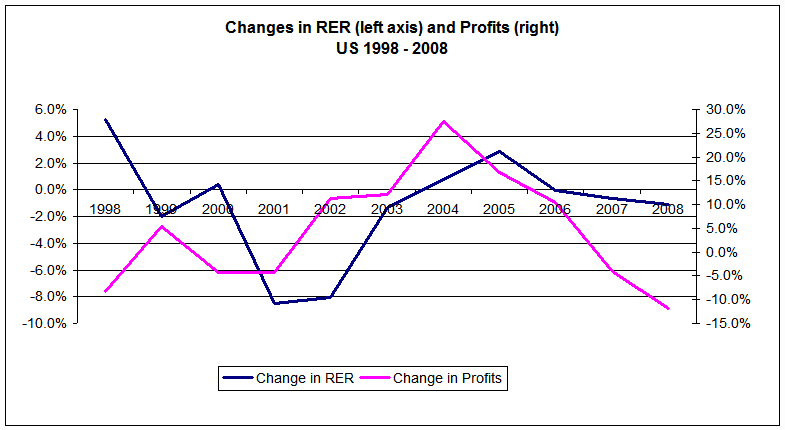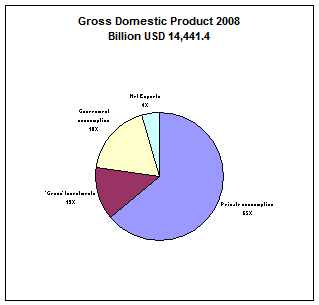Government Economic Lies, The Grossly Problematic Gross Domestic Product
Economics / Economic Statistics Jul 28, 2010 - 05:41 AM GMTBy: LewRockwell
 Richard C.B. Johnsson writes: There might be many other valid concerns about the concept of Gross Domestic Product, but the perhaps most acute one is that one particular component of the Gross Domestic Product (GDP) remains on a net basis. How about that, such a widely used and supposedly gross measure has a mix of gross and net components! There can’t be any logical justifications for that at all. Obviously, a net measure should only have net components and a gross measure only have gross components, but mixing gross and net terms seems completely illogical and inconsistent.
Richard C.B. Johnsson writes: There might be many other valid concerns about the concept of Gross Domestic Product, but the perhaps most acute one is that one particular component of the Gross Domestic Product (GDP) remains on a net basis. How about that, such a widely used and supposedly gross measure has a mix of gross and net components! There can’t be any logical justifications for that at all. Obviously, a net measure should only have net components and a gross measure only have gross components, but mixing gross and net terms seems completely illogical and inconsistent.
Regardless of whether you are an experienced analyst, a student or a complete layman, you simply have to be aware of this. And if you read on, you will learn of an alternative gross measure, including some real numbers and a new analytical tool as well as the explosion of a major popular myth.
The Net Term and Avoiding Gross Mistakes
The definition of GDP is (we leave exports/imports out for now):
GDP = C + I + G |
(1) |
where C is private consumption expenditure, I is gross investment expenditure and G is government consumption expenditure. The ‘I’ component in turn is defined as:
I = gross investments in fixed assets + net investment in inventories and work-in-progress |
(2) |
Here lies the problem and inconsistency; one gross and one net investment component added together to form a ‘gross’ investment component. There is of course no logical validity in mixing gross and net terms like that, as already mentioned. But because of the wide usage of GDP and the risk of drawing wrong conclusions if you base them on illogical input, we better figure out how to adjust for this.
Let’s start having a look at the Net Domestic Product (NDP):
profits + wages = NDP = C + Inet + G |
(3) |
where Inet is the net investments. (3) simply states that net income in the left-hand-side equals net expenditure on the right-hand-side. Note that in NDP, there are no gross components, making it logically consistent.
If we are looking for a proper gross measure, we need to add things on both sides of (3), i.e. both the left-hand income side and the right-hand expenditure side, in order to maintain the equality. Specifically, we need to add to the profits on the left-hand-side and net investments on the right-hand-side (It’s generally assumed that wage income on the left-hand-side and the consumptions expenditure on the right-hand-side don’t involve any accruals or capitalization, thus making the net and gross amounts equal).
The gross income measure corresponding to profits is sales revenue, or turnover, since:
profits = sales revenue – costs |
(4) |
The corresponding gross income of the net investment is productive expenditure, since:
net investment = productive expenditure – costs |
(5) |
where the productive expenditure (B) is all expenditure made by companies, including (i) gross investments on fixed asset, (ii) gross investments in inventories and work-in-progress as well as (iii) current expenditure. An example of the first is the amount spent on building a new factory started and finished within that year. Examples of the second are the amount spent on computer software and on wages and inputs for products to be your future sales. An example of the third would be stationary or travel expenses. The corresponding costs would be categorized either as (i) depreciation (of fixed assets), (ii) cost-of-goods-sold (from the inventories or work-in-progress) or (iii) current expenses (exactly the same as the expenditure itself).
(The perhaps most ingenious part is figuring out (5). Note that current expenditure are expenditure that is accounted for as costs within the same year, i.e. no capitalization or accruals involved, and should definitely not be part of the net investments, but since these are included in both terms on the right-hand-side of equation (5) they don’t affect the net investment amount on the left-hand-side of (5). Also note that it would perhaps be slightly misleading to call the ‘productive expenditure’ ‘gross investment’, since part of it never will become net investment. Hence, I follow Reisman (1996) and use ‘productive expenditure’.)
We see from (4) that the difference between sales and profit are the costs and that from (5) that the difference between productive expenditure and net investments also is the same costs. Now we know enough in order move from NDP to a gross level. Starting again with (3), we add costs according to (4) to the left-hand-side and the same costs to the right-hand-side according to (5):
(profits + costs) + wages = NDP = C + ( Inet + costs )+ G |
(6) |
Then we get:
sales revenue + wages = GDR = C + B + G |
(7) |
The sum we can call Gross Domestic Revenue (GDR), in line with George Reisman (see especially pp. 609–708 of his Capitalism – A Treatise On Economics).
This is by far the best summary of the overall income and expenditure I have found, but there are some other examples around. It’s a gross measure that contains only gross components and is solidly based on well-accepted national and business accounting principles. And here’s a bonus – it’s fairly straight-forward to compute based on existing statistics.
Example – US GDR 1997–2008
To calculate GDR for the US, we rely on numbers available online from BEA (www.bea.gov). NDP numbers are easy to find but we also need numbers on Gross Output (i.e. domestic sales revenue) from the Input-Output tables, as well as profits. In order to end up with GDR, we want to add total business costs to NDP – so we can take sales revenue, deduct profits and then add the corresponding costs to NDP. That’s enough to calculate GDR:

Voilà, now we have calculated GDR. Unfortunately, the numbers for 2009 aren’t all available at this time.
The Size of Gross Spending
Next, let’s make a comparison between NDP, GDP and GDR from various perspectives, learning some new facts and also exploding a major and extremely common myth. Because of the net term in GDP, most of the gross business expenditure during a year is left out. GDR in fact out-sizes GDP by a factor 2.6 for the US in 2008. That’s a major difference on any scale.
How come people miss out on most of the gross business revenue and expenditure when trying to measure gross income or expenditure? Well, this problem was present already in J.E. Meade and R. Stone’s 1941 seminal article on the subject, Expenditure, Savings and Investment, appearing in The Economic Journal, vol. 51 (1941), pp. 216–233. In this article, Meade and Stone outlined what later became the UN standard on aggregate accounting. In that article they deal mostly with the net national product, but there is a short passage where they claim that "depreciation, renewals, repairs, etc" should be added to net investment to reach the gross investment. Thus, the problem has been there from the start. Meade and Stone simply didn’t get this part right, they missed out on all the gross spending on inventories and work-in-progress, i.e. the major part of business expenditure (interestingly, Stone was later awarded the Bank of Sweden Prize in Economic Sciences in Memory of Alfred Nobel for his "fundamental contributions to the development of national accounts", and also Meade was later awarded the Nobel Prize).

But why does the GDP measure still appear relevant, despite being so wrong? Well, one reason could be that it’s not very far from being NDP, and NDP has some importance. So most studies based on NDP might do just as well using NDP, but that empirics I leave to you.
What about the issue of double-counting? Well, that’s a real hobby horse of armchair economists. Try to tell a business person that just invested $100,000 on fixed assets and another $100,000 on input for goods that his gross spending only was $100,000, and ask if s/he agrees. And ask the other business person if he just received $200,000 or only $100,000 in revenue. I can understand that someone that never has spent time in doing business, like some arm-chair professors or some young students, can make the double-counting claim, but that doesn’t make it a valid claim. For a more formal refutation of that silly idea, please have a look at Reisman’s "The Value of 'Final Products' Counts Only Itself: Today's Gross Product is Net Product".
Finally, sometimes you see comparisons between the turnovers of large multinational companies to the GDP of countries. Well that’s like comparing net and gross, since GDP is very close to a purely net level while the turnover is a measure of gross sales. On the other hand, comparing the gross sales revenue to GDR might be more justified, if still interesting.
Exploding Myth – The Consumption-Driven Economy
One of the greatest myths of our time, so counter-intuitive and yet so appealing, is that we become wealthy by consuming, not only as a whole country or whole world, but also as families and individuals. So most official policies today are directed to promoting mindless consumerism or wasteful government programs (all of them really to be categorized as consumption). And borrowing is no problem as long at the money is spent quickly on consumption, the mantra seems to be for government officials all over the world today. And people that want to pretend to be smart repeat the mantra, often with bad consequences for their personal finances.
To eat the seed corn might be a very simple thing to do, but in fact it’s rather simplistic. The more of the seed corn you eat, the less will you will have in the future. So even though completely counter-intuitive, crazy theories like this have been raised to science by people and organizations that benefit from such theories. The biggest benefactor of this is the government itself, since almost all of its activities fall into that category. All the time it has to raise more money through other means since very little of its goods and services are paid for or even worth paying for if it wasn’t for the monopoly status.
Anyhow, this silly idea is actually gets strong support by the use of the illogical GDP measure, since private consumption according to GDP is more than 2/3 of overall spending and government spending another 2/10 or so in many developed countries. The US numbers for 2008 are 70.1% and 20.0%, a massive 90.1%. So even the most critical student or person has trouble arguing against more consumption expenditure if basing the argument on GDP or trying to get around it at all.
However, once we relate private and government expenditure to GDR a totally different picture emerges. Suddenly we see the vast majority of spending during a year is in fact made as investments on such things as fixed assets, inventories and work-in-progress by various businesses. In the US in 2008, 67.5% was productive expenditure, while "only" 26.8% and 7.6% was private and government expenditure, respectively.
|
|
Note: The net exports were actually negative in 2008, but show up in the diagrams as positive,
but that doesn’t affect the conclusions since the overall amounts are relatively small.
So by the use of GDR, we can also explode the myth that a country can be consumption-driven. Only in a parallel reality of mathematical modeling where cause and effect doesn’t exist can someone come up with the idea that statistical aggregates are "driven" by something. Saying that you become rich by more consumer demand is to reverse things in a very bad way. The more a country produces, the more it can consume. Everything that is produced will eventually be consumed, as Say’s law states, because the goods already produced create their own demand by being available for exchange. That is rather intuitive.
Now you have the facts to blow up the idea of Keynesian Konsumerism.
Emphasis on Production Instead of Consumption
But while all of this might be true, accepting it after this short paper might not be that easy. In order to give you some further convincing food for thought, I will also introduce you to a concept I used the first time in 2005 called the Relative Expenditure Ratio (RER) (see primarily Deflation and Japan Revisited). This ratio relates the productive expenditure to the expenditure made on consumption. Defining the RER as the ratio between the [B+NX] expenditure and the [C+G] expenditure, the change in RER is given by the next diagram (change on the left-hand axis).

In the diagram, I have also included the changes in GDR and GDP (right axis). Interestingly, the changes in RER coincide with the changes in the overall level of GDR expenditure to a very large extent. Thus, whenever more spending is directed towards production relative the expenditure on consumption, the overall amount of spending is also growing. The more one spends on production, the more the total spending grows, and hence also the ability to consume.
Please note that there is no circular reasoning here, no dependent variable, since there is nothing that logically says that the relation between the parts of the whole has to have anything to do with the change in size of the whole itself.
If growth is an overall aim, then this has clear implications. Focus should in that case be on finding good policies for leaving businesses to expand their productive operations instead of trying to stimulate various kinds of consumption.
Since RER is based on GDR and not on GDP, the usefulness of RER could be seen as yet another argument in favor of the use of GDR over GDP. I’ve included figures on GDP change just to show how the changes in RER seem to predict changes in GDP as well, probably best explained by the fact that GDP is very similar to NDP.
I have also included a diagram comparing changes in RER to profits, and also in this case we can see a rather high correlation where changes in profit seem to precede changes in RER. It seems perfectly natural that business change their spending quicker than people change their consumption; this is a well-known fact. When profits are shrinking, this is taken as a signal by businesses to cut productive spending. Even though such cut backs might create less room for private and government consumption spending as well, the productive expenditure is a much larger amount, thus the following fall in RER. And when profits are on the rise, businesses spend more and RER rises, thereby likely making more room for consumption as well.
Also note that since a business can earn profits from both intermediate sales (i.e. other companies’ productive expenditure) and consumption, there is very little circular reasoning in this case as well.

Finally, let me note that RER and its two parts could also be compared with industrial production, consumer and producer prices and sales revenue with interesting results (see primarily Deflation and Japan Revisited based on Japanese national accounts, but also Why the GDP Shows No Bust, but GDR Does based on BEA numbers. There’s also work in Swedish based on Swedish national accounts available upon request.).
Concluding remarks
There’s certainly something grossly problematic about the Gross Domestic Product, and I hope I at least have been able to sow some seeds of agreement on that. I also hope to hear less about silly ideas like a consumption-driven economy, since GDR help us to realize that there are no such things. Keynesian Konsumerism is a fake. I also hope that the introduction of the Relative Expenditure Ratio might spur people to use this concept for analyzing growth, profits and many other things, as I know some professional analysts are already doing.
Richard C.B. Johnsson [send him mail] holds a Ph.D. in economics and is of Swedish origin. He works as a financial advisor in one of Asia's great capitals, managing offshore investments for clients from all over Southeast Asia.
© 2010 Copyright LewRockwell / Richard C.B. Johnsson - All Rights Reserved
Disclaimer: The above is a matter of opinion provided for general information purposes only and is not intended as investment advice. Information and analysis above are derived from sources and utilising methods believed to be reliable, but we cannot accept responsibility for any losses you may incur as a result of this analysis. Individuals should consult with their personal financial advisors.
© 2005-2022 http://www.MarketOracle.co.uk - The Market Oracle is a FREE Daily Financial Markets Analysis & Forecasting online publication.





